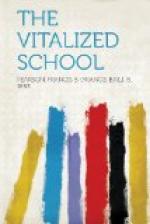1. In what ways is agriculture a typical study?
2. Why was its importance not realized until recently?
3. What educational agency in your state first reflected the need of scientific instruction in agriculture?
4. The study of agriculture in the public school was at first ridiculed. Why? What is now the general attitude toward it?
5. To what extent is the study of agriculture important in the city school? Is there another subject as important for the city school as agriculture is for the rural school?
6. Mention some school subjects that are closely related to agriculture. Show how each is related to agriculture.
7. Is Luther Burbank’s work to be regarded as botanical or as agricultural? Why? To which of these sciences do plant variation and improvement properly belong?
8. In many schools agriculture and domestic science are associated in the curriculum. What have they in common to justify this?
9. In the chemistry class in a certain school food products are examined for purity. How will this increase the pupils’ knowledge of chemistry?
10. In a certain school six girls appointed for the day cook luncheon for one hundred persons, six other girls serve it, and six others figure the costs. Criticize this plan.
11. Show how some particular phase of agricultural instruction may function in agricultural practice.
12. What benefits accrue to a teacher from the study of a subject in its ramifications?
13. In what respects is agriculture a noble pursuit? Compare it in this respect with law. How does agriculture lead to the exercise of faith? Teaching? Law? Electrical engineering?
CHAPTER XVII
THE SCHOOL AND THE COMMUNITY
=An analogy.=—If we may win a concept of the analogy between the vitalized school and a filtration-plant, we shall, perhaps, gain a clearer notion of the purpose of the school and come upon a juster estimate of its processes. The purpose of the filtration-plant is to purify, clarify, and render more conducive to life the stream that passes through, and the function of the school may be stated in the same terms. The stream that enters the plant is murky and deeply impregnated with impurities; the same stream when it issues from the plant is clear, free from impurities, and, therefore, better in respect to nutritive qualities. The stream of life that flows into the school is composed of many heterogeneous elements; the stream that issues from the school is far more homogeneous, clearer, more nearly free from impurities, and, therefore, more conducive to the life and health of the community. The stream of life that flows into the school is composed of elements from all countries, languages, and conditions. In this are Greeks and barbarians, Jews and Gentiles, saints and sinners, the washed and the unwashed, the ignorant, the high, the low, the depraved, the weak, and the strong.




